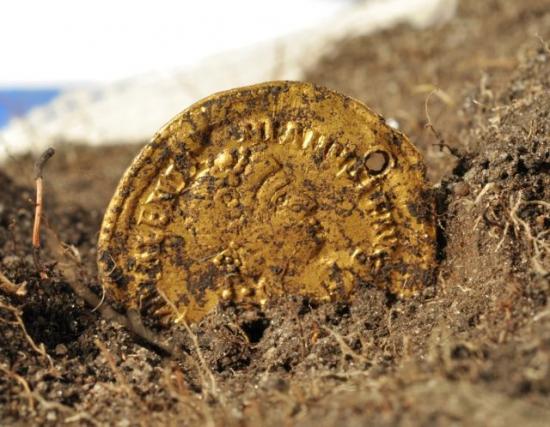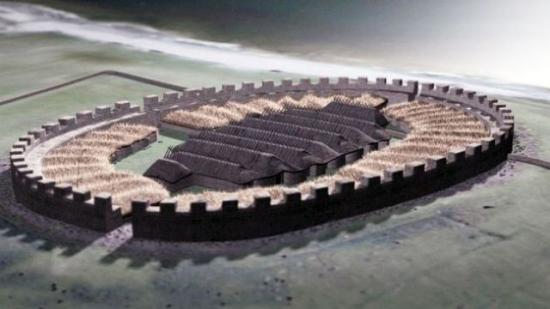Annalee Newitz
Source - http://arstechnica.com/science/2016/02/remains-at-iron-age-fort-tell-a-story-of-a-horrible-massacre/
 A Roman coin found at the site of Sandby Borg, whose inhabitants probably included a number of unemployed Roman soldiers. - Max Jahrehorn Oxides
A Roman coin found at the site of Sandby Borg, whose inhabitants probably included a number of unemployed Roman soldiers. - Max Jahrehorn Oxides
On Öland, an island off the coast of Sweden, archaeologists have unearthed the remains of a 1,500-year-old fort whose inhabitants were brutalized in such an extreme way that legends about it persist to this day. As researchers piece together the fort's final days, it sounds like they're telling a horror story.
Possibly hundreds of people sheltering behind the fort's defenses were executed and abandoned, their bodies left to rot in place without burial. Their wounds were indicative of execution. And some of their mouths were stuffed with goat and sheep teeth, possibly a dark reference to the Roman tradition of burying warriors with coins in their mouths.
None of their considerable wealth was looted, which is highly unusual. Researchers have found barely hidden valuables in every house they've excavated. Even the livestock was left behind after the slaughter, locked up to die of starvation. This is even more bizarre than the lack of looting. On an island with scarce resources, it would have been considered a waste for victors (or neighbors) to leave healthy horses and sheep behind after battle.
It was a bizarre, kill-all-zombies-style attack.
The people of this fort were being shunned, consigned to a "humiliation worse than death," according to archaeologist Helena Victor, who is heading up the dig. We may never know what caused them to suffer such an unusual punishment, but their fate tells us a lot about what life was like on this island in the mid-400s CE.
Andrew Curry has an incredible article about Victor and her colleagues' work in Archaeologymagazine. He explains that these ruins date to an era of violent transition on Öland. The Roman Empire was falling apart, and Öland suffered. We know the island had direct ties to Rome because there is an extremely large number of Roman coins and other trinkets there. It appears that many of Öland's best soldiers served in the Roman military, bringing freshly minted coins back with them.
But when there were no more military jobs for these soldiers, they had to return to island life in the mid-400s. Around that time, people on Öland began building massive fortifications called borgs. The borgs are all roughly similar in plan: earthen walls made with Roman-style gates, some 15 feet high, encircling small villages and their food stores.
 An artist's recreation of what Sandby Borg would have looked like in 400 CE. Kalmar County museum
An artist's recreation of what Sandby Borg would have looked like in 400 CE. Kalmar County museum
The shunned fort, with its slaughtered inhabitants, was one such village. Today known as Sandby Borg, it once enclosed more than 50 family homes. Some 36 percent of the Roman coins found on Öland come from Sandby Borg and surrounding areas, so archaeologists speculate that it was home to a number of these unemployed soldiers.
Regardless of how many soldiers there were, the people of Sandby Borg didn't last long. Writes Curry:
What archaeologists call the “cultural layer” inside the fort, the accumulated trash and debris of daily life, is thin. People lived there for a few months, at most, using it as a shelter rather than a home. “It was obviously built as a refuge and never really occupied,” says [archaeologist Ulf] Näsman, who is helping excavate House 40’s hearth. That’s a sign that the community that sought protection behind Sandby Borg’s once-mighty walls was an early loser in the unrest that tore the island apart. “When the power struggle started, we think people moved into the fort and brought everything with them,” says Victor. “And then everything stopped. Nothing happened after this massacre.”
Before the fateful event that left everyone dead, it appears that Sandby Borg's inhabitants knew danger was coming. In at least five houses, Victor and her colleagues found valuables buried just to the left of the front door. She speculates that this was a local custom: if the family was killed, relatives would know where to look for valuables. The fact that so many families buried their jewelry and coins at the same time is a sure sign that this attack was no surprise.
We will probably never know why Sandby Borg was destroyed so thoroughly—and in such an ugly way. From the skeletons uncovered so far, Victor and her colleagues believe it was no pirate raid. This was a political act—another group on the island wanted to consolidate power. And it worked. The shunning was total. Even today, people in local villages say they were warned not to visit the ruins as children because of ghosts and curses.
For once, superstition has actually helped the progress of science. Because people were afraid to loot or touch Sandby Borg, the town has remained frozen in time, with all its artifacts intact. It offers archaeologists a perfect snapshot of life in the mid-400s, at a time of dramatic transition for Europe.
The researchers have only examined 2 percent of the site, and Victor is hoping the Swedish government will grant permission for them to excavate further.